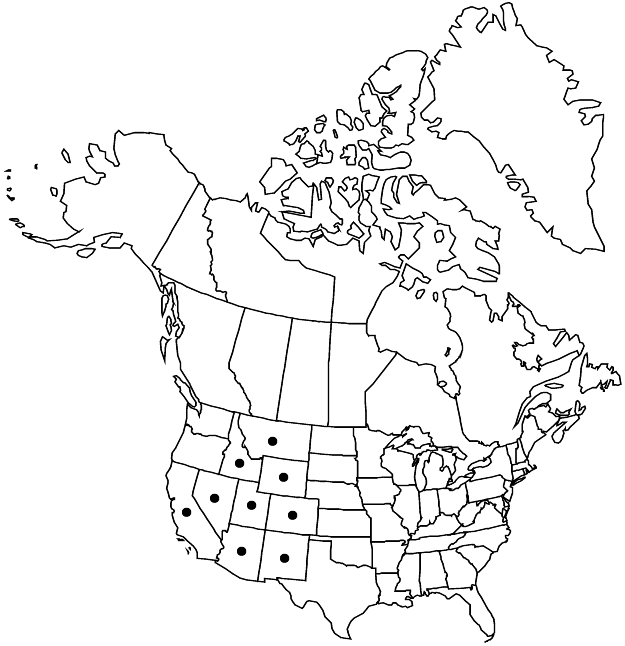Eriogonum microtheca var. simpsonii
Taxon 32: 293. 1983.
Shrubs, (1–)2–15 × 4–16 dm. Stems: caudex absent; aerial flowering stems 0.2–0.7 dm, densely lanate to tomentose, sometimes floccose, rarely glabrous. Leaves: blade narrowly elliptic, 0.5–1.8(–2.5) × 0.1–0.2 cm, densely whitish-tomentose abaxially, mostly whitish-floccose adaxially, margins revolute or nearly so. Inflorescences (1.5–)2–4(–6) cm; branches tomentose to floccose, rarely subglabrous or glabrous. Involucres 2–3 mm, tomentose to floccose or subglabrous. Flowers 2–3 mm; perianth white to pink or rose. Achenes 2–3 mm.
Phenology: Flowering Jun–Oct.
Habitat: Clayey to gravelly or occasionally sandy washes, flats and slopes, mixed grassland, saltbush, blackbrush, and sagebrush communities, pinyon-juniper and montane conifer woodlands
Elevation: 1400-2300 m
Distribution

Ariz., Calif., Colo., Idaho, Mont., Nev., N.Mex., Utah, Wyo.
Discussion
Variety simpsonii is the common expression of the species in the southern part of the species’ range. It occurs in northern Arizona, southeastern California, western and south-central Colorado, central and southern Nevada, northern New Mexico, Utah, and southwestern Wyoming.
Populations most similar to the type occur mainly on the Colorado Plateau in northern New Mexico, southern Colorado, and in northeastern Arizona and southwestern Utah; these are low shrubs usually less than 3 dm tall with thinly tomentose to floccose leaf blades, flowering stems, and inflorescence branches. As such, these plants resemble, and are sometimes confused with, small forms of Eriogonum leptophyllum. In east-central and northeastern Utah, and in northwestern Colorado, there are similar plants but, unlike the more southern phase with its tightly revolute, linear leaf blades, here the leaf blades are somewhat broader and tend to be glabrous. These plants are outwardly similar to E. microthecum var. phoeniceum. Similar depauperate individuals are found elsewhere, most notably in east-central Nevada where the plants have even broader leaf blades and instead of being dark green the plants are light green and whitish. Such plants are found on clayey substrates and will either key out here or, with some difficulty, to var. lapidicola. The variety is disjunct in the Salmon River Valley of Lemhi County, Idaho (Reveal & Welsh 4485 & 4486, BRY, NY, UTC) and in Beaverhead County, Montana (Shelly & King 1150, MONTU). These populations are found in close association with known Native American villages and may well have been introduced in pre-Columbian times as var. simpsonii is known to have been used in certain rites associated with “witchcraft.”
West of the Colorado Plateau, in northwestern New Mexico and across the northern tier of counties in Arizona, plants are tall, open shrubs. This expression is common throughout the southern portion of the Great Basin and on the desert ranges of eastern California. At its extreme, the expression is markedly different from that represented by the type of the variety, but there is a complete intergradation from one to the other, and no attempt is made here to parse them into taxonomic entities.
Selected References
None.